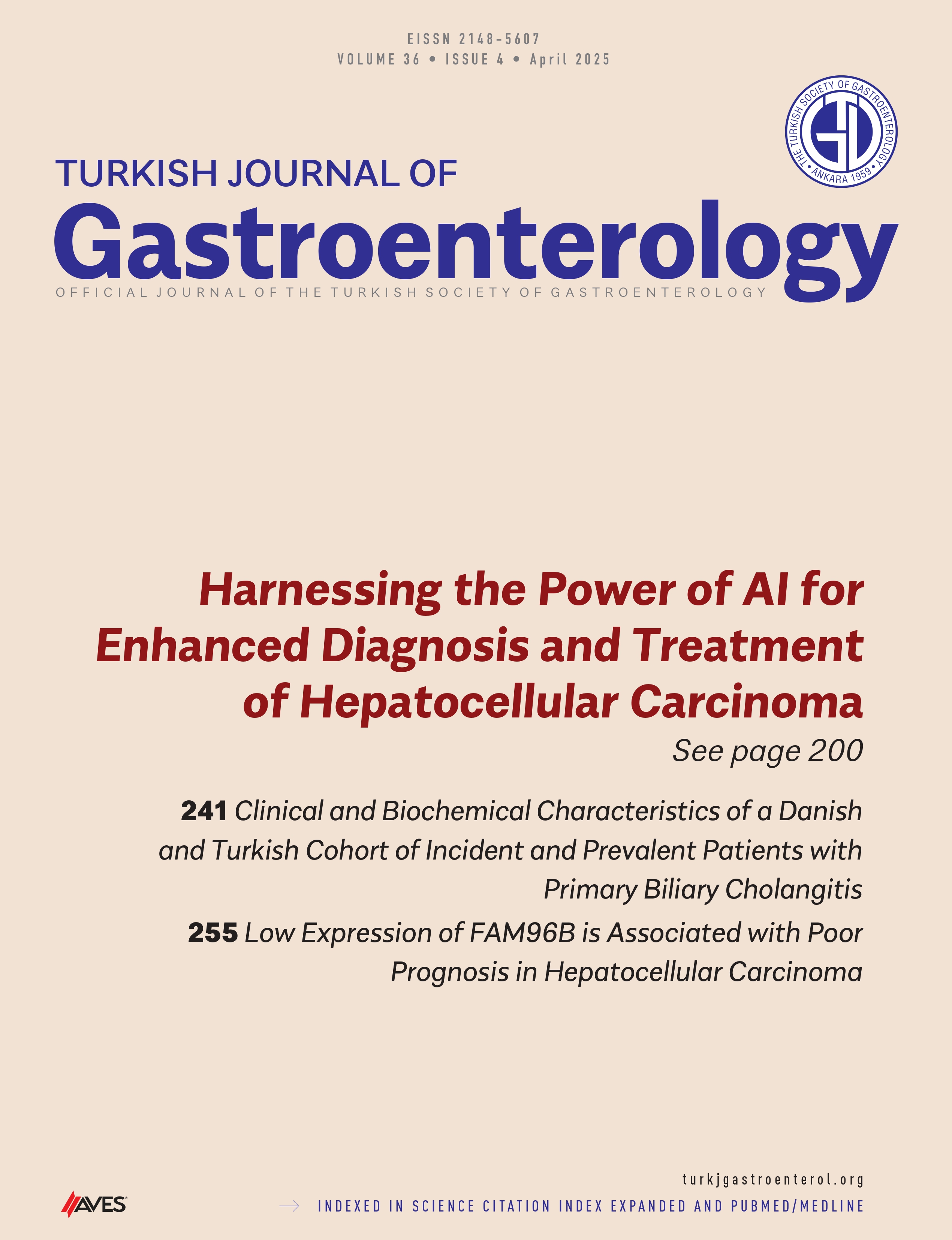Low Expression of FAM96B is Associated with Poor Prognosis in Hepatocellular Carcinoma
Main Article Content
Abstract
Background/Aims: Recently, studies on FAM96B functions mainly focused on its role in maintaining the normal physiological function of cells. However, the clinical implications of FAM96B in hepatocellular carcinoma (HCC) are still unclear.
Materials and Methods: FAM96B mRNA expression was detected in human HCC tissues and the matched nontumorous tissues by quantitative real-time reverse transcription (qRT-PCR) and then validated in The Cancer Genome Atlas (TCGA) database. Immunohistochemistry assay (IHC) was performed on all 137 cases of HCC samples to examine the protein level of FAM96B. Subsequently, the associations between FAM96B expression and clinicopathological parameters and prognosis were further analyzed.
Results: The mRNA level of FAM96B was found to be significantly lower in HCC tissues compared to non-tumorous tissues, as observed in both the local hospital and TCGA database.Immunohistochemistry assay analysis revealed a decrease in FAM96B expression in 78 out of 137 cases, which was significantly associated with larger tumor size, higher Barcelona clinic liver cancer or Child stage, and early distant metastasis. Patients with low FAM96B levels tended to have an unfavorable disease-free and overall survival. Moreover, FAM96B was identified as an independent predictor of patient prognosis in both univariate and multivariate survival analyses. Mechanistically, FAM96B was found to inhibit cancer progression by inducing apoptosis in liver cancer cells and inhibiting their growth.
Conclusion: Our findings provide the first evidence suggesting the involvement of FAM96B in the progression of HCC. Additionally, FAM96B could potentially serve as a marker for tumor recurrence and prognosis in HCC patients.
Cite this article as: Tang Y, Tang L, Du H, et al. Low expression of FAM96B is associated with poor prognosis in hepatocellular carcinoma. Turk J Gastroenterol. 2025;36(4):255-262.
Article Details
References
1. Sung H, Ferlay J, Siegel RL, et al. Global cancer statistics 2020: GLOBOCAN estimates of incidence and mortality worldwide for 36 cancers in 185 countries. CA Cancer J Clin. 2021;71(3):209-249. [CrossRef]
2. Kollar J, Drizdal T, Vrba J, et al. Microwave catheter navigation system for the radiofrequency liver ablation. Cancers (Basel). 2022;14(21):5296. [CrossRef]
3. Zhang K, Wang T, Zhou H, et al. A novel Aurora-A inhibitor (MLN8237) synergistically enhances the antitumor activity of sorafenib in hepatocellular carcinoma. Mol Ther Nucleic Acids. 2018;13:176-188. [CrossRef]
4. You X, Jiang W, Lu W, et al. Metabolic reprogramming and redox adaptation in sorafenib-resistant leukemia cells: detected by untargeted metabolomics and stable isotope tracing analysis. Cancer Commun (Lond). 2019;39(1):17. [CrossRef]
5. Dileepan M, Ge XN, Bastan I, et al. Regulation of eosinophil recruitment and allergic airway inflammation by tropomyosin receptor kinase A. J Immunol. 2020;204(3):682-693. [CrossRef]
6. Ridder DA, Urbansky LL, Witzel HR, et al. Transforming growth factor-beta activated kinase 1 (Tak1) is activated in hepatocellular carcinoma, mediates tumor progression, and predicts unfavorable outcome. Cancers (Basel). 2022;14(2):430. [CrossRef]
7. Ghouri YA, Mian I, Rowe JH. Review of hepatocellular carcinoma: epidemiology, etiology, and carcinogenesis. J Carcinog. 2017;16:1. [CrossRef]
8. Costentin CE, Bababekov YJ, Zhu AX, et al. Is it time to reconsider the Milan criteria for selecting patients with hepatocellular carcinoma for deceased-donor liver transplantation? Hepatology. 2019;69(3):1324-1336. [CrossRef]
9. Sayiner M, Golabi P, Younossi ZM. Disease burden of hepatocellular carcinoma: a global perspective. Dig Dis Sci. 2019;64(4):910-917. [CrossRef]
10. Karaoğullarından Ü, Üsküdar O, Odabaş E, et al. Hepatocellular carcinoma in cirrhotic versus noncirrhotic livers: clinicomorphologic findings and prognostic factors. Turk J Gastroenterol. 2023;34(3):262-269. [CrossRef]
11. Hu T, Li J, Zhang C, et al. The potential value of microRNA-4463 in the prognosis evaluation in hepatocellular carcinoma. Genes Dis. 2017;4(2):116-122. [CrossRef]
12. Yang W, Itoh F, Ohya H, et al. Interference of E2-2-mediated effect in endothelial cells by FAM96B through its limited expression of E2-2. Cancer Sci. 2011;102(10):1808-1814. [CrossRef]
13. Xiong XD, Wang J, Zheng H, et al. Identification of FAM96B as a novel prelamin A binding partner. Biochem Biophys Res Commun. 2013;440(1):20-24. [CrossRef]
14. Stehling O, Vashisht AA, Mascarenhas J, et al. MMS19 assembles iron-sulfur proteins required for DNA metabolism and genomic integrity. Science. 2012;337(6091):195-199. [CrossRef]
15. Ito S, Tan LJ, Andoh D, et al. MMXD, a TFIIH-independent XPD-MMS19 protein complex involved in chromosome segregation. Mol Cell. 2010;39(4):632-640. [CrossRef]
16. Zhang XH, Chen XJ, Yan YB. Fam96b recruits brain-type creatine kinase to fuel mitotic spindle formation. Biochim Biophys Acta Mol Cell Res. 2023;1870(2):119410. [CrossRef]
17. Liang H, Li W, Yang H, et al. FAM96B inhibits the senescence of dental pulp stem cells. Cell Biol Int. 2020;44(5):1193-1203. [CrossRef]
18. Zhang DD, Sun XL, Liang ZY, et al. FAM96A and FAM96B function as new tumor suppressor genes in breast cancer through regulation of the Wnt/beta-catenin signaling pathway. Life Sci. 2022;308:120983. [CrossRef]
19. Chen MY, Juengpanich S, Hu JH, et al. Prognostic factors and predictors of postoperative adjuvant transcatheter arterial chemoembolization benefit in patients with resected hepatocellular carcinoma. World J Gastroenterol. 2020;26(10):1042-1055. [CrossRef]
20. Wu X, Wan R, Ren L, et al. Circulating microRNA panel as a diagnostic marker for hepatocellular carcinoma. Turk J Gastroenterol. 2022;33(10):844-851. [CrossRef]


